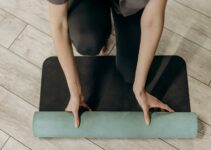Looking for gentle fitness routines that can improve your overall health? Try incorporating yoga for flexibility and strength, pilates for core stability, swimming for cardiovascular health, walking for stress reduction, tai chi for balance and relaxation, and barre workouts for muscle toning into your fitness regimen. These routines are specifically designed to cater to women's health needs and can be easily integrated into your daily routine. Whether you're a beginner or have been exercising for years, these gentle fitness routines offer a variety of options to help you stay healthy and active.
Key Takeaways
- Yoga and mindfulness enhance body awareness, promote relaxation, and improve flexibility and strength.
- Pilates and core stability exercises emphasize the mind-body connection, improve posture and stability, and strengthen core muscles.
- Swimming is a low-impact exercise that enhances cardiovascular health, reduces stress, and improves technique and endurance.
- Walking reduces stress, triggers the release of endorphins, promotes mindfulness, and provides social connection opportunities.
Yoga for Flexibility and Strength
Improve your flexibility and strength through yoga practice. By incorporating breathing exercises and mindfulness into your yoga routine, you can enhance your body awareness and deepen your practice. Mindful breathing during yoga helps in relaxing your mind and body, allowing you to focus on the present moment and release any tension. Additionally, meditation can be integrated into your yoga sessions to promote a sense of calm and reduce stress. Through consistent yoga practice, you'll develop a heightened awareness of your body's movements and alignment, leading to improved flexibility and strength. Embracing these aspects of yoga not only nurtures physical well-being but also cultivates mental clarity and emotional balance. So, as you engage in your yoga practice, remember to integrate breathing exercises, mindfulness, meditation, and body awareness for a holistic approach to health and wellness.
Pilates for Core Stability
Enhance your core stability through Pilates, building upon the flexibility and strength gained from yoga practice. Pilates emphasizes the mind-body connection, focusing on precise movements that engage and strengthen your core muscles. By integrating breathing techniques with controlled movements, Pilates helps improve your posture and overall stability. The exercises target deep abdominal muscles, teaching your body to move efficiently and with proper alignment. This mind-body awareness developed through Pilates not only enhances your physical strength but also promotes better posture and alignment in daily activities. As a result, you'll experience improved balance and stability, reducing the risk of injury and discomfort. Incorporating Pilates into your fitness routine can further support your overall well-being and contribute to a strong, stable core.
Swimming for Cardiovascular Health
If you're looking for a low-impact, full-body workout, swimming might just be the perfect fit for you. It offers a multitude of benefits for your cardiovascular health while being gentle on your joints. In the upcoming discussion, we'll cover the specific advantages of swimming, as well as technique and safety tips to help you get the most out of this fantastic exercise.
Benefits of Swimming
Experience improved cardiovascular health by incorporating swimming into your fitness routine. Swimming offers a plethora of benefits that can have a positive impact on your overall well-being. Here are three reasons why swimming is beneficial for your cardiovascular health:
- Low Impact Exercise: Swimming provides a great cardiovascular workout without putting stress on your joints, making it an ideal option for individuals with joint pain or arthritis. The buoyancy of water reduces the impact on your body, allowing for a comfortable and effective workout.
- Technique Improvement: Engaging in different swim strokes not only adds variety to your workout but also helps in enhancing your swimming technique. As you improve your technique, you'll increase your cardiovascular endurance and overall fitness level.
- Stress Reduction: The rhythmic nature of swimming, combined with the calming effects of being in water, can help reduce stress and anxiety, contributing to better heart health and overall well-being.
Technique and Safety
To improve your cardiovascular health through swimming, focus on mastering proper technique and adhering to safety guidelines. Proper form is crucial for maximizing the benefits of swimming while minimizing the risk of injury. Keep your body streamlined, head in line with your spine, and kick from your hips to reduce drag and increase efficiency. Injury prevention is also key, so make sure to warm up before swimming and incorporate rest periods into your routine. Additionally, consider using equipment like goggles and swim caps to protect your eyes and hair. Remember to stay hydrated and listen to your body for any signs of overexertion. By prioritizing technique and safety, you can make the most of your swimming workouts while safeguarding your overall well-being.
| Technique Tips | Safety Guidelines |
|---|---|
| Keep body streamlined | Warm up before swimming |
| Head in line with spine | Incorporate rest periods |
| Kick from hips | Use protective equipment |
| Stay hydrated | Listen to your body |
Walking for Stress Reduction
Looking to reduce stress in your life? Walking might just be the answer. Not only does it provide a great opportunity to clear your mind, but it also offers physical benefits. Let's explore the benefits of walking, tips for making the most of your walks, and how to easily incorporate walking into your daily routine.
Benefits of Walking
When you walk regularly, you can effectively reduce stress and improve your overall well-being. Walking is not only a physical activity but also a powerful stress-reliever. Here's why it's so beneficial:
- Natural Mood Booster: Walking triggers the release of endorphins, the body's natural feel-good hormones, helping to alleviate feelings of stress and anxiety.
- Mindfulness Practice: Taking a walk allows you to be present in the moment, focusing on the sights and sounds around you. This mindfulness can help to clear your mind and reduce stress levels.
- Social Connection Opportunity: Walking with friends or family provides an opportunity for social interaction, which can offer emotional support and a sense of connectedness, further reducing stress.
Regular walking can be a simple yet effective way to manage stress and improve your overall well-being.
Tips for Walking
Start incorporating daily walks into your routine to actively reduce stress and improve your overall well-being. When walking for stress reduction, pay attention to your posture. Keep your head up, shoulders back, and engage your core muscles. This not only helps in improving posture but also reduces muscle tension, contributing to stress relief. Additionally, walking at a brisk pace can help boost your metabolism, aiding in weight management and overall energy levels. Consider adding intervals of faster walking or including uphill routes to increase the intensity and metabolism-boosting benefits of your walk. By focusing on your posture and adding intensity to your walks, you can maximize the stress-reducing and metabolism-boosting benefits of this simple yet effective form of exercise.
Incorporating Walking Daily
To actively reduce stress and improve overall well-being, incorporate daily walks into your routine and pay attention to your posture while walking. Walking is a simple yet effective way to alleviate stress and boost your mood. Here are three ways walking can help you manage stress and improve your mental well-being:
- Power walking for weight loss: Engage in brisk walking to not only burn calories but also release endorphins, which can help reduce stress and anxiety.
- Nordic walking for full body workout: Incorporate Nordic walking with poles to engage your upper body muscles, promoting relaxation and a sense of well-being.
- Mindful walking for stress reduction: Practice mindful walking by focusing on your breath and the sensations in your body, promoting relaxation and reducing stress.
Incorporating these walking techniques into your daily routine can significantly contribute to stress reduction and overall mental well-being.
Tai Chi for Balance and Relaxation
Improving balance and relaxation, incorporate Tai Chi into your fitness routine for its gentle yet effective movements. Tai chi benefits your physical and mental health by promoting strength, flexibility, and balance. This ancient Chinese practice also emphasizes the mind-body connection, helping you stay present and focused during each movement. The slow, flowing motions of Tai Chi can reduce stress and anxiety while improving overall well-being. By engaging in Tai Chi, you can enhance your posture, coordination, and stability. Its low-impact nature makes it suitable for individuals of all fitness levels, and it can be particularly beneficial for women looking to improve their balance and find a sense of calm in their daily lives. Consider adding Tai Chi to your routine for a harmonious approach to fitness and relaxation.
Barre Workouts for Muscle Toning
Incorporate barre workouts into your fitness routine for targeted muscle toning, complementing the balance and relaxation benefits of Tai Chi. Barre techniques involve small, precise movements that work multiple muscle groups, helping you achieve long, lean muscles. The benefits of barre workouts include improved posture, increased flexibility, and enhanced muscle strength, giving you a toned and sculpted physique. To get started, all you need is a sturdy chair or a ballet barre for support, along with comfortable workout attire that allows for unrestricted movement. By incorporating barre workouts into your fitness routine, you'll not only tone your muscles but also improve your overall strength and flexibility, helping you feel confident and empowered in your own body.
- Achieving long, lean muscles
- Improved posture and flexibility
- Feeling confident and empowered
Frequently Asked Questions
Are There Any Specific Yoga Poses or Routines That Are Especially Beneficial for Women's Reproductive Health?
For women's reproductive health, specific yoga poses like prenatal yoga can support hormonal balance and fertility. These routines may also help alleviate menstrual cramps. Incorporating these poses into your fitness regimen can provide numerous benefits.
Can Pilates Help With Postpartum Recovery and Strengthening the Pelvic Floor Muscles?
Pilates can help with postpartum core strength and flexibility, as well as strengthening the pelvic floor muscles. It's an effective way to target these areas, aiding in postpartum recovery and overall women's health.
How Can Swimming Benefit Women Who Are Experiencing Menopausal Symptoms, Such as Hot Flashes and Mood Swings?
Swimming benefits women experiencing menopausal symptoms by helping manage hot flashes and mood swings. It provides a low-impact, full-body workout, promoting cardiovascular health and reducing stress. Incorporating yoga poses can further support menstrual health.
Is There a Recommended Walking Routine or Technique That Can Help With Managing Anxiety and Depression in Women?
To manage anxiety and depression, try incorporating mindful breathing and relaxation techniques into your walking routine. Focus on nature walks and grounding exercises to help calm your mind and lift your spirits.
Can Tai Chi Be Helpful for Women Who Are Experiencing Symptoms of Osteoporosis or Arthritis?
Yes, tai chi can help relieve symptoms of osteoporosis and aid in managing arthritis. The gentle movements and weight-bearing nature of tai chi benefit bone health and joint flexibility, providing therapy for these conditions.


